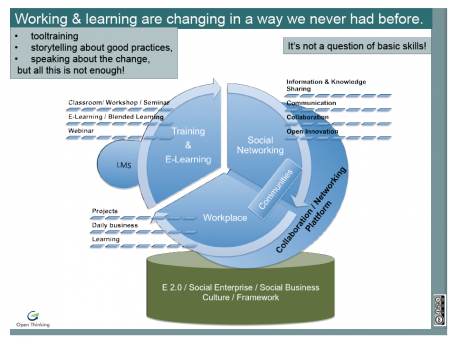This idea of being inspired by the marketing, I expressed it during a workshop about social learning and employee engagement in social business process, with an HR audience, during the last Enterprise 2.0 summit. Few years ago, I wouldn’t have said that, but I think it is true, even if the sentence is a little bit provocative. Customers are not identical, as the marketing finally understood, employees either. However, when you look at a roll-out strategy for social business, you have this feeling. No adaptability

At the beginning of the web, the marketing approach was « one to many ». So one marketing speech for the different stakeholders. With the web 2.0, based on more interaction and a better targeting of the stakeholders, a « one to one » strategy was deployed. Last one, still ongoing, the « many to many » approach where all employees are possibly a contact for customers and applicants. To sum up, an ambassador program. Like this IBM advertising described it.
[youtube]http://www.youtube.com/watch?v=_SbVnMMozY4[/youtube]
Let’s go back to the roots of this discussion, the employee engagement for a social business transformation project. I’ve published a post on this blog about multiculturalism, and the impacts of cultures on social business project management. In the comments, John Ingham underligned the concept of polyphony in the enterprise. Everyone is different :
- locale culture (country)
- management level
- job description
- maturity level
- …
However, often, all deployment strategies look the same. Even if people say that they need to be adapted, because of costs issues or lack of experience, finally you have a unique approach. Moreover, as for the marketing approah, the « one to many » can’t manage the workload for all the employees, and seldom an internal ambassador program exists (there is some exception, like IBM, which has set up a strong ambassador program, that’s why I’ve chosen this advertising too).
Still during this workshop, the issue about a one way training has been questionned.  Again, a multiple approach is necessary and the usual training programs are not a sufficient answer. The Ellen Trude‘ slide at the top of the post shows the limits of a unique training approach inside the enterprise. But can we train to be social, that’s a real question.
Most of all, any educationalist will confirm that we don’t learn the same way. A social business project is strongly related to the human factor, so a polyphonic approach is necessary to deploy it and make it grow.

